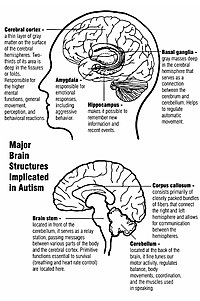
Photo from wikipedia
Human endogenous retroviruses (HERVs) are relics of ancestral infections and represent 8% of the human genome. They are no longer infectious, but their activation has been associated with several disorders,… Click to show full abstract
Human endogenous retroviruses (HERVs) are relics of ancestral infections and represent 8% of the human genome. They are no longer infectious, but their activation has been associated with several disorders, including neuropsychiatric conditions. Enhanced expression of HERV-K and HERV-H envelope genes has been found in the blood of autism spectrum disorder (ASD) patients, but no information is available on syncytin 1 (SYN1), SYN2, and multiple sclerosis-associated retrovirus (MSRV), which are thought to be implicated in brain development and immune responses. HERV activation is regulated by TRIM28 and SETDB1, which are part of the epigenetic mechanisms that organize the chromatin architecture in response to external stimuli and are involved in neural cell differentiation and brain inflammation. We assessed, through a PCR realtime Taqman amplification assay, the transcription levels of pol genes of HERV-H, -K, and -W families, of env genes of SYN1, SYN2, and MSRV, as well as of TRIM28 and SETDB1 in the blood of 33 ASD children (28 males, median 3.8 years, 25–75% interquartile range 3.0–6.0 y) and healthy controls (HC). Significantly higher expressions of TRIM28 and SETDB1, as well as of all the HERV genes tested, except for HERV-W-pol, were found in ASD, as compared with HC. Positive correlations were observed between the mRNA levels of TRIM28 or SETDB1 and every HERV gene in ASD patients, but not in HC. Overexpression of TRIM28/SETDB1 and several HERVs in children with ASD and the positive correlations between their transcriptional levels suggest that these may be main players in pathogenetic mechanisms leading to ASD.
Journal Title: International Journal of Molecular Sciences
Year Published: 2022
Link to full text (if available)
Share on Social Media: Sign Up to like & get
recommendations!